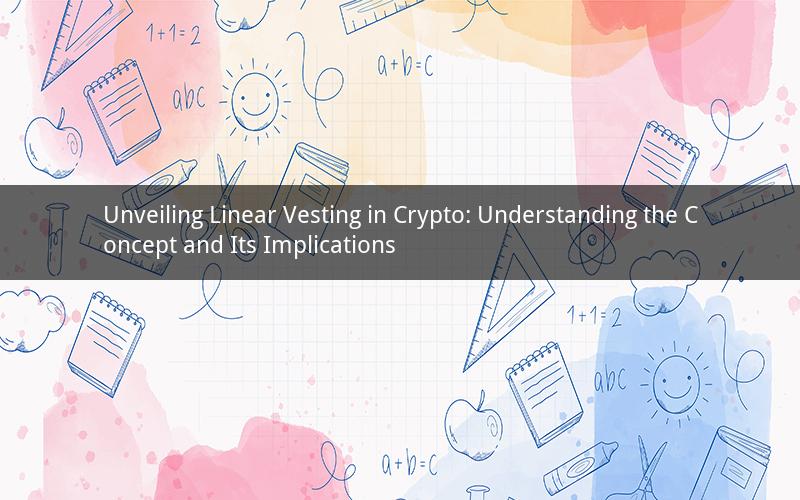
Linear vesting in crypto refers to a vesting schedule that distributes tokens or coins to investors or team members at a consistent rate over a predetermined period. Unlike other vesting schedules, such as cliff vesting or cliff-and-grace vesting, linear vesting ensures a steady and predictable flow of tokens. This article aims to delve into the concept of linear vesting in crypto, its benefits, and its potential implications.
1. What is linear vesting in crypto?
Linear vesting in crypto is a vesting schedule that distributes tokens or coins to investors or team members at a consistent rate over a predetermined period. This means that the recipient receives a fixed number of tokens or coins each month or year, depending on the terms of the vesting agreement. The primary purpose of linear vesting is to incentivize long-term commitment and align the interests of investors or team members with the success of the project.
2. How does linear vesting work?
The process of linear vesting involves the following steps:
a. Determination of the total number of tokens or coins: The first step is to determine the total number of tokens or coins that will be vested over the predetermined period. This number is usually based on the initial investment or the value of the tokens at the time of the agreement.
b. Calculation of the vesting period: The vesting period is the duration over which the tokens or coins will be distributed. This period can range from a few months to several years, depending on the project's needs and the agreement between the parties involved.
c. Distribution of tokens or coins: Once the total number of tokens or coins and the vesting period are determined, the tokens or coins are distributed to the recipient at a consistent rate over the vesting period. For example, if there are 1,000 tokens to be vested over a 24-month period, the recipient will receive 41.67 tokens each month.
3. Benefits of linear vesting in crypto
a. Incentivizes long-term commitment: Linear vesting encourages investors or team members to stay committed to the project for the long term, as they will continue to receive tokens or coins over the vesting period.
b. Predictable token distribution: Linear vesting provides a predictable and consistent flow of tokens or coins, which can help in planning and managing the project's finances.
c. Mitigates the risk of early exit: By distributing tokens or coins over a predetermined period, linear vesting reduces the risk of investors or team members exiting the project early and selling their tokens, which could negatively impact the project's value.
4. Potential implications of linear vesting in crypto
a. Impact on liquidity: Linear vesting may affect the liquidity of the tokens or coins, as the recipient can only sell a portion of their tokens or coins during the vesting period.
b. Tax implications: Linear vesting may have tax implications for investors or team members, as they may be required to pay taxes on the vested tokens or coins at the time of distribution.
c. Market volatility: The value of tokens or coins can be highly volatile, which may impact the amount of tokens or coins received during the vesting period.
5. Frequently asked questions about linear vesting in crypto
Q1: What is the difference between linear vesting and cliff vesting?
A1: Linear vesting distributes tokens or coins at a consistent rate over a predetermined period, while cliff vesting requires a certain period of time to pass before any tokens or coins are vested.
Q2: Can linear vesting be terminated early?
A2: Yes, linear vesting can be terminated early, but this may result in a loss of vested tokens or coins.
Q3: How does linear vesting affect the value of tokens or coins?
A3: Linear vesting can affect the value of tokens or coins, as it may lead to a consistent and predictable flow of tokens or coins, which can impact the market supply and demand.
Q4: Can linear vesting be adjusted during the vesting period?
A4: Yes, linear vesting can be adjusted during the vesting period, but this may require the consent of all parties involved.
Q5: Is linear vesting suitable for all crypto projects?
A5: Linear vesting may not be suitable for all crypto projects, as it depends on the project's needs, the nature of the tokens or coins, and the preferences of the investors or team members.
In conclusion, linear vesting in crypto is a vesting schedule that distributes tokens or coins at a consistent rate over a predetermined period. This approach incentivizes long-term commitment, provides predictable token distribution, and mitigates the risk of early exit. However, it also has potential implications, such as impact on liquidity, tax implications, and market volatility. Understanding the concept of linear vesting and its implications is crucial for investors, team members, and crypto projects to make informed decisions.